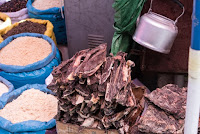 It's our first full day in Lhasa and we're all catching our breath (and catching up on sleep as the 14-hour jet
lag chases us along). Before our trek begins in earnest, we have three scheduled "exploration and acclimatization" days in Lhasa -- not only to help us to understand the culture and traditions of Tibet -- but also to begin to adjust to our next three weeks at high altitude.
It's our first full day in Lhasa and we're all catching our breath (and catching up on sleep as the 14-hour jet
lag chases us along). Before our trek begins in earnest, we have three scheduled "exploration and acclimatization" days in Lhasa -- not only to help us to understand the culture and traditions of Tibet -- but also to begin to adjust to our next three weeks at high altitude.
So, one of the trekking questions we most often get concerns how we make sure we can handle high altitude. The answer is that we really can't (no one can). In fact, Sir Edmund Hillary, the first man to ever summit Mount Everest, was never able to climb another Himalayan Peak after Everest because of altitude sickness. One's reaction to life in thin air is unpredictable and there is no sure way to guarantee a problem-free ascent. To help us to adjust all four trekkers are taking the prophylactic drug, Acetazolamide (trade name, Diamox). Simply stated, Diamox increases the acidity of the blood (by increasing excretion of bicarbonates (read, you'll pee A LOT)), thereby fooling one's body into thinking it has excess CO2, which it eliminates through faster and deeper breathing (thereby increasing the O2 level of the blood). So what do we do to increase our likelihood of thriving at high altitude? We get as fit as possible to manage the strenuous work of trekking (panting is a given -- get used to it). We give ourselves over to "better living through chemistry" (a Diamox toast anyone?). And we remember that no summit or pass is worth the life-threatening consequences of going too high, too fast.
In Lhasa (12,000'), we begin our staged acclimation -- gratefully and patiently exploring starting this morning with:
The Jokhang Temple at the center of the Barkhor. This is considered the most significant shrine in all Tibet for the presence of the Jowo S(h)akyamuni -- the most revered Buddha image in all Tibet. The image is believed to have been created from the actual appearance of the Buddha by a celestial architect, and in fact dates back to 7th Century when a Chinese princess brought the statue to Tibet as part of her marriage dowry in 641 (a year that also coincides with the foundation of Buddhism in Tibet).
The gilded Jowo statue itself resides in a special chapel deep in the Jokhang Temple where it is protected by guardian kings and fierce
protectors. The presentation is both breathtaking and surprising given the
opulence of the vestibule and particularly the jewel-encrusted crown on the
Sakyamuni’s head.
No photographs of the Jowo are allowed. The beauty and significance of
the statue launched my internet search to include a properly cited photo
here:
 |
| Beth Harris, "Jowo Shakyamuni, Jokhang Temple, Lhasa, Tibet. Yarlung Dynasty, brought to Tibet in 641(?) Gilt metals with semiprecious stones, pearls, and paint; various offerings," in Smarthistory, March 29, 2016, accessed July 3, 2018, https://smarthistory.org/jowo-rinpoche-jokhang-temple-tibet/4129795123_9f0ceca113_b/. |
In the temple we joined the crushing flow of pilgrims and of other tourists being lectured by their respective guides. As we wound our way through chapels and anterooms, I became increasingly uncomfortable that my curious presence was an encroachment of sacred space. On the 2d floor of the Jokhang the selfie-stick extravaganza became too much for me. I returned to the Temple sans guide, in silence. A totally different experience . . ..
 |
| Selfies on Steroids at the Jokhang |
At all of Tibet's temples, palaces and monasteries, there is a practice of giving gifts ranging from food, flowers and tokens to money and valuables (or in the case of many, of tourists being asked to leave a donation in order to take photographs). Our guides confirmed our understanding that these monetary gifts, admission fees and supplementary charges are collected by the Chinese government, with only a small stipend going back to the temples, palaces and monasteries.
In the afternoon we visited the much smaller Ramoche Temple situated off the beaten path (mostly unexplored by tourists) in a separate area of the Tibetan quarter. This temple, which also includes a significant image of Sakyamuni as a child, is perhaps best known as the first home of the Jowo now at the Jokhang. At Ramoche, there are in-residence monks -- many of whom were present and visible. The faithful were walking the (much smaller) Kora around Ramoche and prostrating for merit -- free for the most part from gawking eyes and intrusive feet. The interior of the temple felt accessible and alive with foot-tamped, rich ochre-colored terrazzo floors; complex Thankga-like murals depicting the
life and mind of Buddha and rules for monks; and the earthy-sweet fragrance of
butter lamps (to clarify the mind and aid in meditation) and incense. Again, no photos allowed -- but my neural Polaroid is a happy one.
 |
| Yak cheese (front right) and barley flour |
 |
| Dried yak meat and un-milled barley |
Returning from Ramoche, we wandered the
streets where Tibetans (versus tourists) shop. The lively exchange of Chinese Yuan for
goods from shoes and housewares to slabs of yak meat, chalky chunks of yak
cheese and barley flour was fascinating. Note: By
1959 -- following the 1950 Chinese invasion of Tibet -- all Tibetan
coins and bills ceased to be made and had no exchange value. The Yuan is the official currency of Tibet.
 |
| This Tibetan man was quite taken by Cliff's size 13 feet |
No comments:
Post a Comment